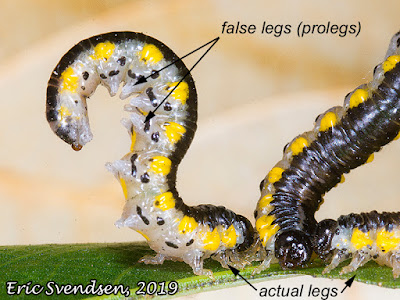Willow sawfly larvae; not a caterpillar.
 |
| Willow sawfly larvae feeding on a willow leaf. |
Initially, one would probably mistake these caterpillar-like creatures as being either butterfly or moth larvae. Both sawflies and lepidoptera (the group butterflies and moths belong to) have similar looking young. The easiest way to tell if it is a caterpillar or sawfly is by paying attention to the prolegs.
Prolegs are those peculiar suction cup type feet that exist at the back end of caterpillars. We know all insects have 6 legs, so why do caterpillars seem to have so many more? It turns out the first three pairs are the true legs. The caterpillar's head is close to them. The rest of the caterpillar has a series of false legs, called prolegs, which continue to the end of the individual. The number of proleg pairs will help identify if it is a sawfly larva or a caterpillar.
It turns out that caterpillars of the lepidoptera only have two to five pairs of prolegs. Sawfly larvae have about six or more pair of them. If you count the prolegs on the above image, you can see that there are clearly 6 pairs.
Willow sawflies belong to the hymenoptera, which is the group of insects that bees, wasps, and ants belong to. Sawfly adults look somewhat like wasps but do not sting. They visit flowers for food much like their cousins. However, the similarities end there. Sawfly young can be serious pests of certain tree species, the willow being chief among them. A large infestation can strip a tree of leaves in a short period of time.
I learned a lot by researching what this interesting insect was; I had never seen one before and was initially fooled into thinking it was a moth or butterfly larva. I searched many dozens of images and could not find the species. I saw some similar looking caterpillars on my search and discovered they were sawflies. Further investigation led me to discovering what they were.
Thanks for reading. www.ericspix.com


Comments
Post a Comment